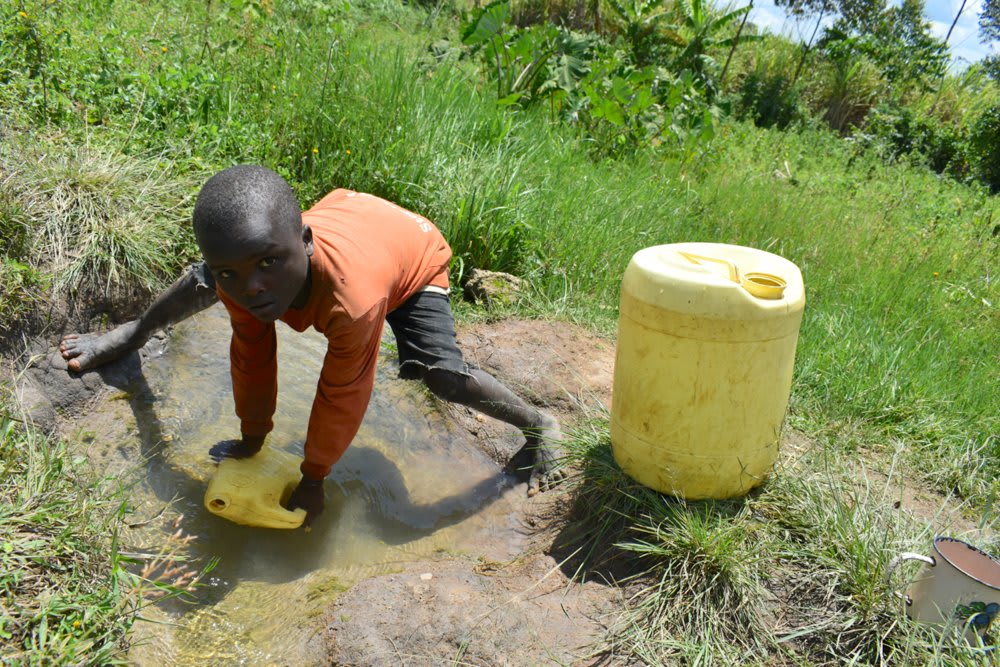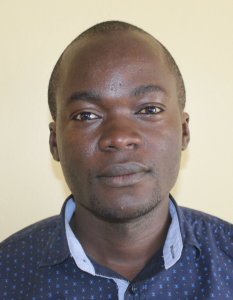It has been decades since the 460 people in the Luyeshe North Community started relying on Tom Mulanda Spring for water, but a myriad of challenges have built up over time with most remaining unsolved.
This has seen the elderly suffering from physical damage while accessing water while the expectant mothers have to look for alternative sources, digging deep into their pockets for the safety of their unborn children.
The unprotected spring is open to all types of contaminants that flow into the spring with runoff from the rains. Animal waste, farm chemicals, trash, and soil are the main contaminants, along with the green algae that is a constant companion in the water. The soil poses an extra challenge at the spring, which looks like just a shallow stream. Sometimes there is so much eroded soil carried into the water that community members have to dig it out to remove it from the spring so there is enough room to collect water again. It also takes a long time for the water to settle after stirring it up in this process. The rainy season only heightens the level of pollution washed into the water.
To fetch water from Tom Mulanda Spring, community members submerge their containers as much as possible directly against the ground, then top them off using smaller jugs to scoop water to then pour into their lager jerrycans. The process is time-consuming and tiring, and it easily stirs up more dirt and sand into the water. People's containers and hands dunked into the water also add any dirt or bacteria that were on them directly into the water they are collecting.
To reach the deepest part of a small pool the community tries to maintain for fetching, most people have to straddle the water - a task particularly difficult for small children, women who are pregnant, and the elderly.

Lines and crowding at the spring are part of the daily routine of fetching water. These, in turn, lead to a lot of wasted time at the spring and less time for other work and activities. People are already going as fast as they can, but fetching water too fast stirs up more sand in the water. The process is simply inefficient.
Community members said they find it difficult to grow and empower themselves due to the time taken in collecting water.
"I am a farmer practicing both livestock production and growing crops, which is my area of specialization, and due to unclean water used by my animals there has been a decrease in production, and most of the time the animals are infected by flukeworms," said 40-year-old farmer Charles Wandabwa.
"My health standards have highly deteriorated causing me to boil the water before drinking it to avoid waterborne infections, which contribute to a high level of poverty as many people spend the little money they have to seek medication. Last but not least, there is a lot of time-wasting as this source offers services to the entire population," Charles added.
Indeed, many people here reported frequent cases of cholera, bilharzia, typhoid, and even skin rashes after consuming the spring water or using it for bathing. But most households cannot afford to spare the extra firewood or time it takes to boil water before drinking it, and fewer people can afford purchasing water treatment methods from the market. Each day spent at home sick means less productive work among adults and fewer school days for children, causing them to fall behind.
"Life has not been good since I was born in this community," said primary school-aged student Stephen.
"Challenges have occurred, weakening my ability to concentrate on my studies as I spend more time collecting water due to its daily need. Good hygiene practices cannot be achieved by using water which is unprotected, thus giving me a hard time as I have to reuse my school uniform and even bathing is not done daily."
What We Can Do:
Spring Protection
Protecting the spring will help provide access to cleaner and safer water and reduce the time people have to spend to fetch it. Construction will keep surface runoff and other contaminants out of the water. With the community’s high involvement in the process, there should be a good sense of responsibility and ownership for the new clean water source.
Fetching water is a task predominantly carried out by women and young girls. Protecting the spring and offering training and support will, therefore, help empower the female members of the community by freeing up more of their time and energy to engage and invest in income-generating activities and their education.
Training on Health, Hygiene, COVID-19, and More
To hold trainings during the pandemic, we work closely with both community leaders and the local government to approve small groups to attend training. We ask community leaders to invite a select yet representative group of people to attend training who will then act as ambassadors to the rest of the community to share what they learn. We also communicate our expectations of physical distancing and wearing masks for all who choose to attend.
The training will focus on improved hygiene, health, and sanitation habits in this community. We will also have a dedicated session on COVID-19 symptoms, transmission routes, and prevention best practices.
With the community’s input, we will identify key leverage points where they can alter their practices at the personal, household, and community levels to affect change. This training will help to ensure participants have the knowledge they need about healthy practices and their importance to make the most of their water point as soon as water is flowing.
Our team of facilitators will use a variety of methods to train community members. Some of these methods include participatory hygiene and sanitation transformation, asset-based community development, group discussions, handouts, and demonstrations at the spring.
One of the most important issues we plan to cover is the handling, storage, and treatment of water. Having a clean water source will be extremely helpful, but it is useless if water gets contaminated by the time it is consumed. We and the community strongly believe that all of these components will work together to improve living standards here, which will help to unlock the potential for these community members to live better, healthier lives.
We will then conduct a small series of follow-up trainings before transitioning to our regularly scheduled support visits throughout the year.
Training will result in the formation of a water user committee, elected by their peers, that will oversee the operations and maintenance of the spring. The committee will enforce proper behavior around the spring and delegate tasks that will help preserve the site, such as building a fence and digging proper drainage channels. The fence will keep out destructive animals and unwanted waste, and the drainage will keep the area’s mosquito population at a minimum.

 Protected Spring
Protected Spring
 Rehabilitation Project
Rehabilitation Project






































